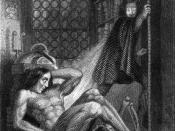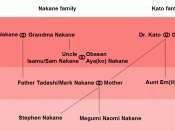LIFE IS NOT ALWAYS FAIR:
The novel Frankenstein by Mary Shelley and Obasan by Joy Kogawa, are both written by female authors. The novels use multiple tenses and similar narrative structure. Both stories deal with moral questioning and help us determine right from wrong. In both cases the outcast is treated badly and with disgust.
The main theme in Obasan is the unjustness of the Canadian Government in World War II. Similarly, Frankenstein illustrates Victor's misuse of dangerous knowledge and his unjustness towards the monster. In Obasan, the Japanese-Canadians suffer discrimination at the hands of the government and from many of the people in Canada. In Frankenstein, the Monster suffers discrimination at the hands of its creator and from society. Shelley creates an intense mental picture of the cruelty shown towards the Monster. Kogawa likewise, displays the anguish that those completely innocent people were put through (simply due to their heritage).
Both the novels deal with moral questioning and help us determine right from wrong.
Both stories use multiple tenses and similar narrative structure. The stories are told in flashback: partly by Victor (in Frankenstein) and Naomi (in Obasan). They are narrated in the first person point-of-view, but the setting of both are far from similar. The story in Frankenstein is supposed to take place in the early 1800's whereas Obasan is set to be in the mid 1900's. Both the novels use a lot of description in their writings.
Throughout the novel Obasan, we see the prejudices and unjust treatment that Japanese-Canadians were forced to endure. Frankenstein on the other hand, depicts the ill-treatment of The Monster by society. In Obasan, the Japanese-Canadians are treated as outcasts whereas the monster is the outcast in Frankenstein. In both cases, the outcast is treated with disgust just...


